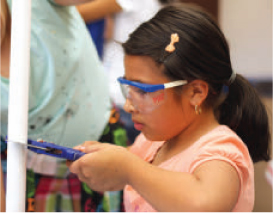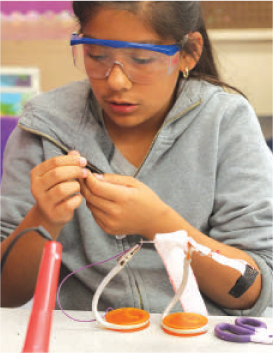Encouraging Girls to Hack and Make
How I created a program in my community to share my love of technology.
Written and photographed by Luz Rivas
I FIRST GOT INTERESTED IN ENGINEERING AND TECHNOLOGY 30 YEARS AGO WHEN I WAS IN FIFTH GRADE. My class had four Apple lie computers, and my teacher taught us to program in Logo and BASIC. This was my first time using technology to create something, and I loved it. In sixth grade, my teacher continued teaching us to program and took some of us to what would now be called a hackathon for kids at our local university. When I entered middle school, I chose to take computer programming again since it was something I was already familiar with. These early experiences sparked an interest in me to pursue a technology career. After high school I was on my way to MIT to study electrical engineering.
Unfortunately, my story is not so common for girls from Pacoima, an underserved community in the Northeast San Fernando Valley of Los Angeles. While most focus on stats that label my community as disadvantaged, we do have an advantage when it comes to making. Pacoima is a community of makers. Growing up, I saw both men and women making things, like their own furniture from scrap wood, toys for their kids, and elaborate dresses for quinceañeras, as well as hacking and fixing electronic household devices.
After working as a hardware engineer, attending grad school at Harvard, and working in science and engineering education for 10 years, I decided to go back to my community and start a program for girls. I wanted to make explicit the connection between making in their community and making with more advanced technology. To do this, I launched the DIY Girls after-school program (diygirls.org) for fifth-grade girls at my former elementary school. The school offered me a dedicated classroom, (which ended up being my own fifth-grade classroom!). With help from volunteers, friends, and teachers, I converted the classroom into a makerspace and recruited girls.
The DIY Girls program is designed to offer experiences that will attract young girls to technology, allow them to express themselves creatively, and give them confidence in their technical abilities. We aim to have an effect on the girls as they enter adolescence and start to form career interests. We meet with 30 students twice a week for two-hour sessions. Through hands-on making activities, girls in our program make real things, like their own toys, wearable electronics, and video games. They learn technical skills including soldering, computer programming, basic electronics, and 3D design. They then apply these skills creatively by designing their own projects and inventions.
Our program focuses on three areas:
Creative Electronics: Girls learn electronics though e-textiles and smart materials like conductive paint. The goal is to be creative while learning basic electronics. They also learn to solder, strip wire, build circuits on breadboards, and use multimeters.
Building and Tinkering: We teach girls to use the basic tools they need to build things. Girls take things apart and learn appropriate ways to use the tools, in addition to safety techniques. We aim to instill confidence through this session.
Product Design: Girls combine the skills developed throughout the year to design and create their own products using a 3D printer, MakeyMakey boards, and other materials. We culminate with a public showcase of the products for families and the community.
DIY Girls has been successful in creating a learning environment where girls take risks, build confidence, and work on projects that attract them to technology. If a girl gets frustrated one day because her program or project didn’t work, she knows she’ll have the opportunity to try again when she returns for the next session. Girls love that they’re learning real skills. Teachers, administrators, and parents have told us that they notice the increase in self-confidence.


I’m excited that the majority of our girls want to continue making things after they go through the program. I plan to teach them more advanced skills like programming and creating projects with the Lilypad Arduino. I’m working on growing the program to serve more girls at more schools and aim to offer summer camps. ![]()
LUZ RIVAS
has experience in engineering, STEM curriculum development, program management, and educational research. She has a B.S. in Electrical Engineering from MIT and a master’s in Technology in Education from the Harvard Graduate School of Education.
